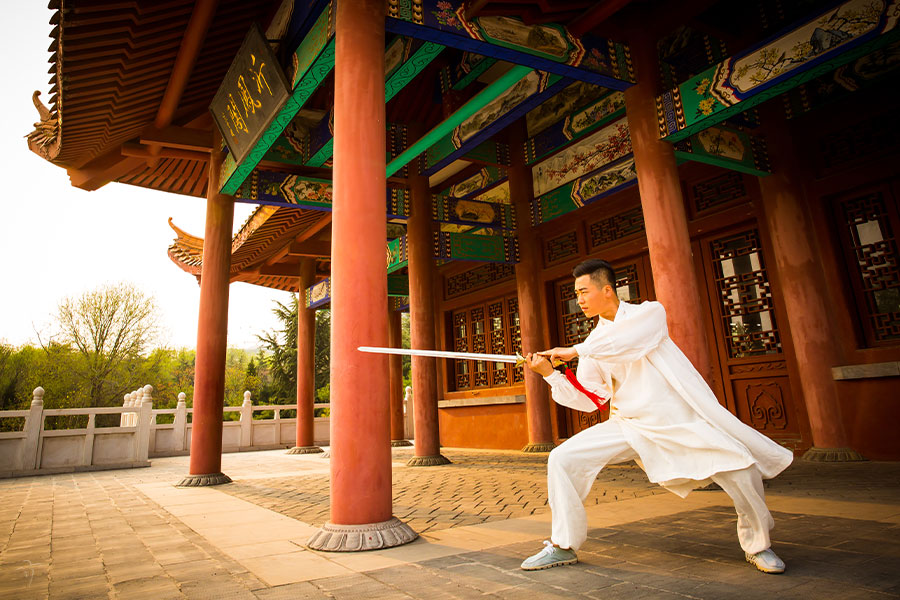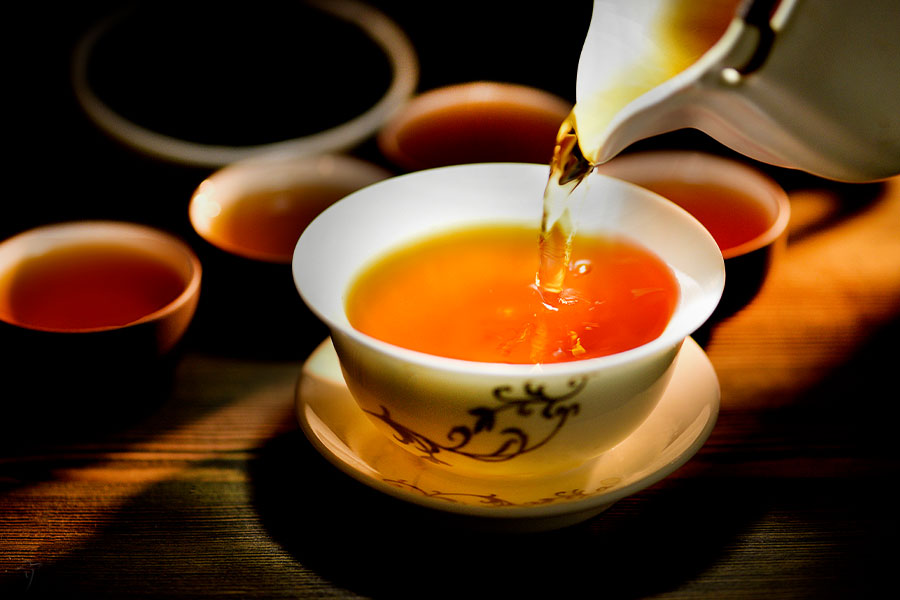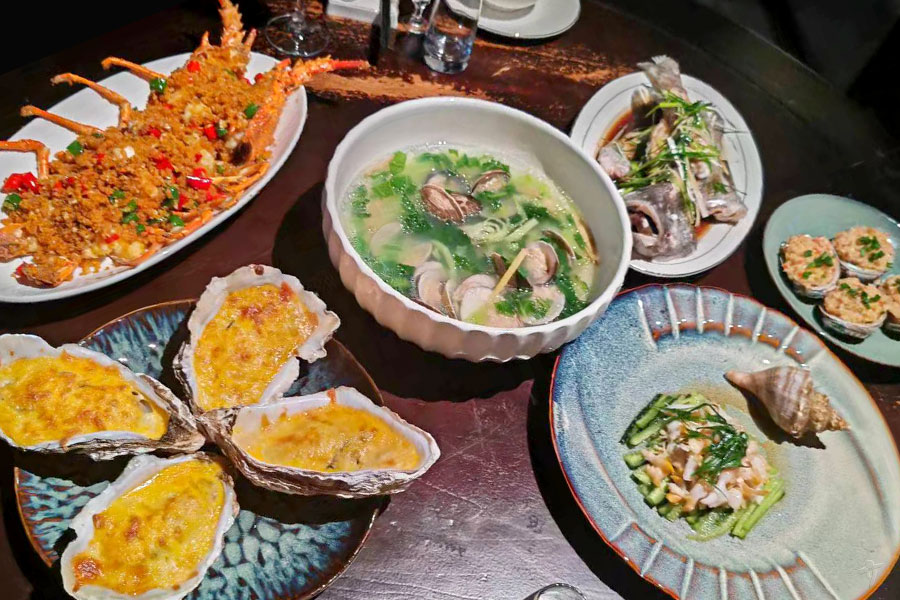2. Main Styles of Traditional Chinese Kungfu

Developing for thousands of years with rich culture and skills, Chinese Kungfu is described to be an ancient towering tree, with styles of boxing being its luxuriant foliage. Hence, it is rare for one to master all of it due to its numerous and complicated styles. As below are the main streams of traditional Chinese martial art, all of which have a long history and have been being popular among Chinese for all the time.
a. Shaolin Kungfu
Birthplace: Shaolin Temple on Song Mountain, Henan Province.
Features: stressing on breath regulating, agile movement, exercising in both inflexibility and yielding.
Representative Martial Styles: Shaolin Five Boxings (Dragon Boxing, Tiger Boxing, Leopard Boxing, Snake Boxing and Crane Boxing), subdivided into decades of sub-classes including Xiaohong Boxing, Dahong Boxing, Laohong Boxing, Arhat Boxing, Shaoyang Boxing, Plum Blossom Boxing, etc.
Most widely known in China among all styles of Kungfu, Shaolin Kungfu is hailed as "the Tai Mountain among Chinese Kungfu", positioned as an excellent attack and defense skill as well as a crucial Chinese cultural Phenomenon.
A Buddhist story goes that Bodhidharma invented the Shaolin Kungfu during the ten years in which he faced the wall for a spiritual retreat. This makes Shaolin Kungfu of Buddhist ideas and cultural connotation from the beginning. However, another idea indicates that the birth of Shaolin Kungfu was to a great degree related to the protection of the Shaolin Buddhist Temple on Mt. Songshan of Henan province. That is, after the building of the temple in the 5th century, the monks practiced martial arts for protecting it, which unwittingly helped to bring about the booming development of Shaolin Kungfu with more and more martial skills from the outside world inserting into it.
Among masses of Shaoling masters, " the eighteen arhats (Chinese pinyin: Shi Ba Luo Han)", the disciples of Sakyamuni, are most famous and unbeatable historical personages in Kungfu. Shouldering a solemn duty of protecting the Shaolin Temple from any inimical invasion and threat, they were also ready to help others for a just cause, for this reason they have been being highly respected by people especially the poor. Afterwards, "the eighteen arhats" became a special antonomasia granted eulogization until today.
The ancient Chinese philosophy believes that man is an integral part of nature, so movements that accord with body structure are considered to be the most logical and best ones. Based on the thought, Shaolin develops its Kungfu by emphasizing on "禅"(Chinese pinyin: Chan), which is a translation coming out of a Sanskrit Buddhist sutras "Tan Jing" and expresses the idea of "deep meditation without distracting thoughts". It is the idea of combining "禅" and "Kungfu" that makes Shaolin Kungfu distinctive from others.
According to the historical records of Shaolin Temple, the skills in Shaolin Kungfu totals 708, but only over 200 of which are passed on to today. Having developed for over 1000 years, it now can be split into Northern Shaolin Kungfu and Southern Shaolin Kungfu, which are adept in the uses of fist positions and kicks respectively.
b. Wudang Martial Art
Birthplace: Wudang Mountain of Jun County, Hebei Province.
Features: conquering the moving with inaction, conquering the unyielding with yielding, conquering the quick with slowness, moving the body with qi.
Representative Martial Styles: Wuji Boxing, Sparrow Hawk Boxing, Monkey Prostrate Boxing, Liu Sui San Shou, Wudang Taiyi Wuxing Boxing, etc.
Stemming between the end of Yuan Dynasty (1271–1368) and the beginning of Ming Dynasty (1368–1644), Wudang Martial Art is said to be created by Zhang Sanfeng, who is respected as the founder of Wudang Taoist Martial Art. It is said that he acquired some boxing skills from Emperor Xuandi in his dream and defeated his enemies by the skills on the next day, hence he decided to create a new kind of martial art that is now known as Wudang Martial Art. However, some historical data shows that Zhang was primitively an excellent disciple of Shaolin Kungfu and the Wudang Martial Art was created on the base of Shaolin.
Fused with the thoughts of two ancient Chinese boos "The I Ching" (Chinese pinyin: Yi Jing) and "The Tao Te Ching" (Chinese pinyin: Dao De Jing), Wudang Martial Art inserted the Taoist theories of Tai Chi, Ying and Yang, Five Elements and Eight Diagrams into its practice and derived its key components: Tai Chi, Ying Yie, Eight Diagrams Palm. Enjoying its fame just after the Shaolin, Wudang Martial Art is agile and changeable as well and pays more attention to life nourishing.
Handed down from generation to generation, Wudang Martial Art has evolved into many branches, with Chen-style Tai Chi (陈氏太极), Yang-style Tai Chi (杨氏太极), Wu-style Tai Chi (吴氏太极), Wu-style Tai Chi (武氏太极) and Sun-style Tai Chi (孙氏太极) being most influential.
The Forty-eight Moves of Tai Chi is a series of Taichi skills and tricks formatted by the previous National Sport Committee of China and Wushu Research Institute of China in 1979. Just its name shows, this style of Tai Chi comprises 48 moves, divided into 6 parts based on the Yang-style Tai Chi, attaching importance to the balance. It takes about 8 minutes to practice it for one time.
C. Emei Martial Art
Birthplace: Emei Mountain, Sichuan Province
Features: slight and changeable moves, conquering the unyielding with the yielding, conquering the powerful by utilizing the powerful’s strength, conquering the moving with inaction, conquering the unmoving with action
Representative Martial Styles: "the Great Four Styles" (Seng-style, Yue-style, Du-style and Zhao-style) and "the Small Four Styles" (Hong-style, Hua-style, Zi-style and Hui-style)
Rooting from Emei Mountain, one of the most Buddhist sacred lands of China in Sichuan Province, the Emei Martial Art is endowed with mystery for being described femininely in many Kungfu novels, TV plays and movies, almost of which show that all of the members of Emei were female or Buddhist nuns with skilled martial art. However, the textual research by the martial art researchers of Sichuan turns out that the origin of Emei Martial Art has nothing to do with female and Buddhist nuns, as it is found to be founded by a man since the Warring States Period (475 BC–221 BC), during which many people escaped to the secluded Emei Mountain. According to the historical book "Record of Emei Mountain", Situ Xuankong was a warrior among the people among the fugitive people. Living in the mountain with monkeys all day long, his inspiration was stirred up by the changeable moves of the monkeys and drew up a flexible martial art of "Monkey Fist Positions". As time passed, more and more disciples solicited to learn the martial and the Emei took its shape gradually. Dramatically, it was linked with female only due to the fictional stories in many popular Kungfu novels.
d. Others Famous Schools & Representative Figures
Drunken Boxing–Huang Feihong (黄飞鸿)
Hong Quan Boxing (洪拳)- Huang Feihong (黄飞鸿)
Yong Chun Boxing (咏春拳)–Ye Wen (叶问)
Jeet Kune Do (截拳道)–Bruce Lee (李小龙)
Related Readings
Top Topics

Chinese Kung Fu
Far and wide known as Kungfu (功夫) all over the world, Chinese martial art is also called Wugong (武功) or Wushu (武术) at home by Chinese people. It ca...

Chinese Tea
Being a vivid Chinese cultural specialty as well as Kungfu and traditional Chinese medicine, Chinese tea has been being developed in China for a lo...

Chinese Cuisine
"Food is the first necessity of the people" is a famous Chinese old saying, which reflects that Chinese have had paid much attention to food si...




